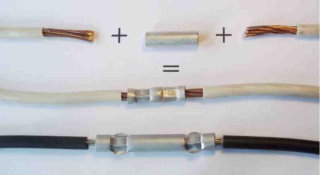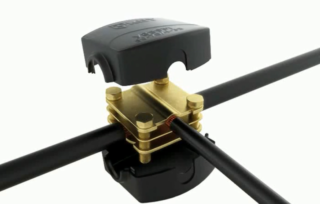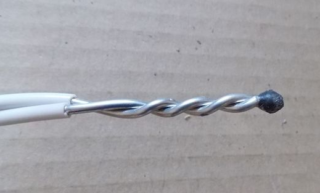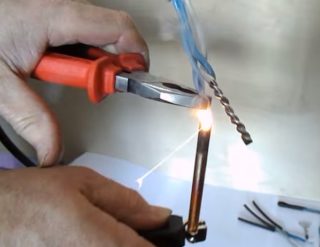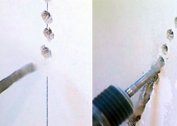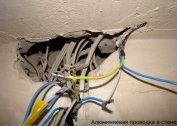Creating a reliable electrical contact when installing the cable is not as easy as it seems. This is especially true for aluminum wires: due to the physical properties of the metal, problems may arise when connecting them.
Features of aluminum wires
According to the PUE standards, it is forbidden to use aluminum conductors during installation in residential premises.
Aluminum wire is a cheap solution, which has an order of magnitude lower price than copper. It is not subject to corrosion, as it is instantly covered with a thick oxide film. It has a low specific gravity.
The main disadvantage is the low electrical conductivity of aluminum. It is 37.9 μS × m, which is almost two times worse than copper, which has 59.5 μS × m. The low flexibility of the conductor makes it impossible to install in places where it is subjected to repeated mechanical stress.
There are four types of wire connections: crimping, compression, welding, soldering. Crimping sleeves and terminal blocks provide easy and quick installation of the cable in places where high mechanical resistance is not needed. Soldering and welding will provide the most durable and reliable connection, but require skill and the use of special tools.
Pressing method
Pressing is carried out with the help of a special sleeve into which the veins are wound, after which they are crimped with a special tool - a crimper. Sleeves vary in diameter, length and material. When installing the cable, only aluminum or brass sleeves must be used. Using brass elements, you can connect both aluminum and aluminum, and copper with aluminum wires.
When connecting aluminum conductors, copper sleeves must not be used. These two metals form a galvanic pair, which leads to accelerated destruction of aluminum.
To connect the cores with different sections, special sleeves with different inlet diameters are used.
The correct choice of the diameter of the sleeve will protect against overheating of the chain section. A larger diameter will give a small contact spot and an increase in resistance. If the cross-section of the sleeve is smaller, it is necessary to reduce the cross-section of the cores, which will also negatively affect the conductive properties.
Compression method
When wiring a cable in a junction box, accidental contact of neighboring cores is extremely undesirable. For this purpose, terminal blocks are used.
The terminal is an insulated sleeve into which the cores are inserted. Inside, either a screw or a spring is used for fixing.
If it is intended to install a stranded wire, it is necessary to crimp it with a special sleeve before installing it into the terminal, which will improve contact and reduce the likelihood of clamping.
Using terminals with a screw connection, it is necessary to clearly control the clamping force in order to avoid cutting the core with a screw and its subsequent destruction. This drawback is deprived of Wago terminal blocks. In them, the vein fixing mechanism is a brass plate and a spring. The use of brass in the composition makes it possible to safely connect cables of different metals.
Welding method
Welding provides the best electrical contact. Due to the homogeneity of the obtained compound, there is no problem of increased resistance of the circuit section.
A welding machine is used with an output power of up to 1 kW and an adjustable voltage in the range of 14-20 V. Welding is considered successful if a drop is formed at the end of the twist, approximately equal to the twist in diameter.
When welding at the end of the twist is carried out by a carbon conductor. The exposure time should not exceed 2 seconds.
There is an option for gas welding wires. An oxide film ceases to form in an inert gas atmosphere, which greatly facilitates the process, but specific knowledge and equipment are required.
Soldering method
Before tinning the surface remove the oxide film. This can be done either by mechanical action, such as sandpaper or a brush with metal bristles, or using a special chemical - flux. It is a white powder that dissolves in water, after which it is applied to the ends of tinned veins.
Oxidation of aluminum in air occurs in a matter of seconds, so that it is not possible to remove the oxides by mechanical action. It is recommended to combine the use of flux and surface cleaning.
If two wires are soldered, a 60 W soldering iron will be sufficient. For wires with a large cross section and when soldering multicore twists, you need a soldering iron with a power of 150 watts or more.
Tin in solder should be at least 50%. You can take solder with 60-90% content.
Soldering aluminum in steps:
- Degrease the surface. Suitable gasoline, alcohol. This will thin the oxide film.
- Lock the cores in the required position.
- Apply flux. Make sure that he gets into the junction of the cables.
- Warm the place of twisting with a soldering iron or gas burner. In the latter case, it is worth being careful, as the metal heats up quickly and can melt.
- Surround the junction. Gently rub the solder with a soldering iron until a uniform shiny film appears.
A properly processed surface acquires a characteristic metallic luster. It is impossible to prevent the appearance of influxes and undeveloped areas.
Tin solder is subject to corrosion, so the finished joint is varnished.
When building wires, if it is expected to operate in difficult conditions, soldered or welded joints will work best. In everyday life, for cables that are not subject to mechanical stress, crimping with a sleeve is quite suitable.

